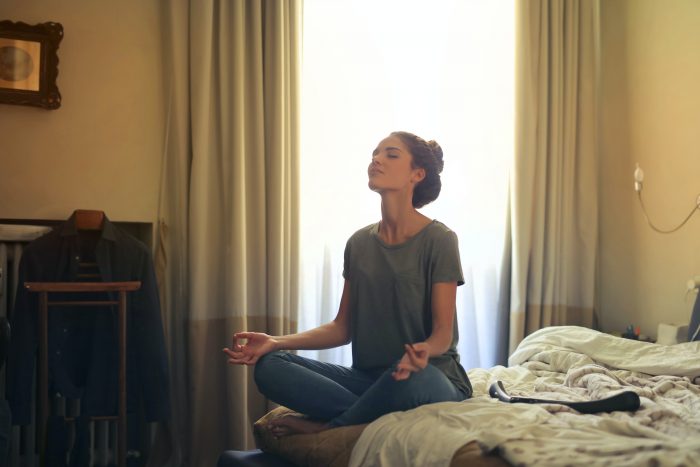The idea of doing a silent retreat had been lingering on my mind for a while.
I had read about its benefits and thought it’d be a great opportunity to clear my mind and reconnect to myself.
A few years ago, I had the opportunity to attend a silent meal; the concept was to meet with random people at someone’s house and have dinner without talking for the first hour—not the place to go if we’re looking to pitch a business idea!
The goal of the activity was to observe ourselves during the silent hour with the hope that once speaking was allowed, we’d be able to dive into deep conversations.
It sounded fascinating, but for some reason—I never showed up.
So, when a friend came back from a 10-day silent retreat last year and shared the incredible things he’d experienced, I was determined to sign up for one myself.
Of course COVID-19 came along and joining a retreat became impossible. But, I didn’t let that stop me—I decided to run my own at home.
The outcome?
A great experience filled with powerful insights that changed the way I look at life.
It was such a profound experience, I could probably write a book about it, but to make things easier—here are my key takeaways:
We’re addicted to stimulation.
As someone who loves being productive and proactive, I was shocked to realize how so many of my daily actions were driven by a mindless need to be busy.
We live in a world that is always on, we’re constantly surrounded by noise, and this has turned us into stimulation addicts.
Do you feel empty if you’re not engaged in some sort of activity?
It’s in the little moments such as making a coffee when tired, mindlessly opening our phone, or even thinking about a potential future outcome—that we struggle to live and appreciate the present moment.
I could clearly see how my mind was taking me places as if it was trying to escape the present moment.
The biggest realization I had through the prolonged periods of silence was that every impression in my mind was purely instinctive and out of my control.
Eventually, the long meditation sessions enabled me to create a space between the external solicitations and my actions.
I felt as if every movement or gesture was coming from a greater place of presence; I was able to appreciate little moments such as looking out of my window and admiring the beauty of the sky.
How can you experience a deeper connection with things when your mind is surmounted by thousands of other thoughts?
We should appreciate sufficiency.
When I normally take “me time,” I love to explore ideas, think about the future, and question possible outcomes. I was secretly hoping that while doing this “retreat,” I’d be able to unlock my creative thinking and come up with my next big idea.
Unfortunately, or perhaps fortunately, the contrary happened.
My need for complex thinking was replaced with a deep desire to reconnect with myself and the simplicity of life. It was as if my needs were gone—I was able to experience a greater body, mind, and heart connection.
During the silent retreat, I would occasionally break things up with a walk to the park, and even though beautiful, I could feel how it was taking me away from my inner self—I was trying to travel outward when the whole point was to move inward.
The benefits aren’t immediate—they are profound.
As soon as I returned to “real life,” things felt a bit confusing; my brain was used to operating slower and more calmly—deciding what to eat felt like planning a trip to Mars.
“There is more to life than simply increasing its speed.” ~ Gandhi
The four main benefits I experienced after the silent retreat were:
>> Increased self-awareness and the ability to detach from stress and anxiety.
>> Clarity of thought and sharpness in actions.
>> The ability to silence the noises in my head and welcome new perspectives.
>> Increased self-compassion and less self-judgment.
How to Create Your Own Silent Retreat:
1. Understand the “why” behind your silence.
What is the real purpose?
What are you hoping to achieve?
Have a clear aim; it will undoubtedly impact the experience and bring new insights.
2. Do some research.
A quick search online will provide plenty of inspiration and practices you can follow during the silence.
My main focuses were: avoiding any type of information consumption, avoiding eye contact, limiting all forms of entertainment (no screen), eating small portions of healthy vegetarian food, and five sessions of 20-minute to one-hour meditations per day.
3. Do some pre-retreat prepping.
Schedule in advance how the day is going to look: when you’ll eat, when you’ll meditate, and when you’ll sleep and wake.
All of this will help automate decisions in your day and allow more mental space to enjoy the present moment.
4. Be mindful of what you put inside your body.
Avoid alcohol and sugar as those will impact your mood. Try to keep it vegetarian, if possible, and stay low on fats.
5. Find the length that works for you.
Silent retreats can be as long as 10 days and as short as two.
6. Early to sleep, early to rise.
Most retreats tend to follow this format—I felt it worked best for me, too.
What’s an early rise?
Any time between 4:00 a.m. and 5.30 a.m.
7. Find the balance that works for you.
Even though the purpose of the retreat is to avoid stimulation, I incorporated 30 minutes to one hour of “extra activities” in my days such as painting, yoga, or a stroll in the park.
My advice is to practice activities you’ve never tried before; it allows new pathways to develop in the brain, which can bring about new insights.
8. Enjoy the present moment and manage expectations.
This is key!
Focus on the beauty of what you are experiencing, take it as it comes, and don’t expect to have revelations right from the start.
9. Give yourself a day to recover.
When the retreat ends, chances are you might feel a little slow—it will take some time to get used to “normal” conditions.
Make sure your next day is not too intense.
Enjoy your experience!
~

 Share on bsky
Share on bsky




Read 7 comments and reply